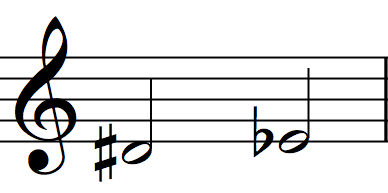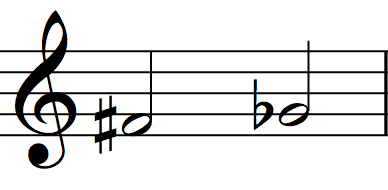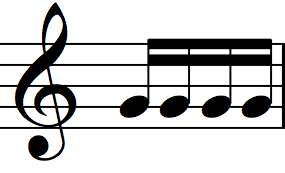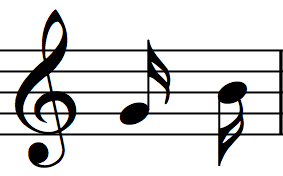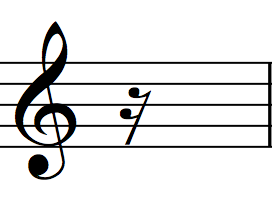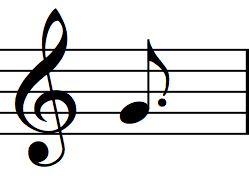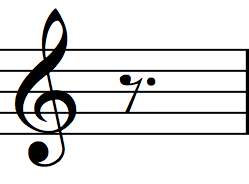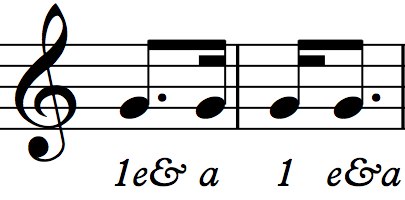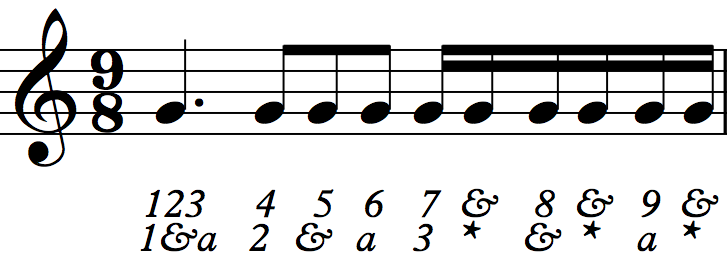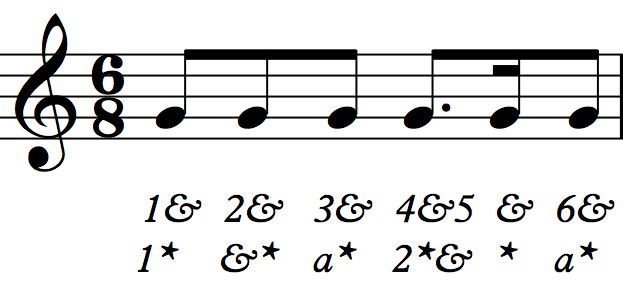13 More Notes, Sixteenth Note Rhythms & Dotted Eighth Note Rhythms
INTRODUCTION
In this unit you will learn more fretted notes on the fourth string, sixteenth rhythms and dotted eighth rhythms. You will also learn how to apply these rhythms in both simple and compound meters.
NOTATIONS
Notes
The Notes ‘D♯’ and ‘E♭’
‘D♯’ and ‘E♭’ are enharmonics. To play ‘D♯’ or ‘E♭’, fret the first fret on the fourth string.
The Notes ‘F♯’ and ‘G♭’
‘F♯’ and ‘G♭’ are enharmonics. To play ‘F♯’ or ‘G♭’, fret the fourth fret on the fourth string.
The Note ‘G’
You already learned to read this note as the open third string. However, this same pitch can be played as the fifth fret of the fourth string as well.
The Sixteenth Note in Simple Meter
In simple meter, a sixteenth note sustains for one-quarter of a beat. The sixteenth note can be written in two ways: either with two beams or two flags.
Beamed Sixteenth Notes
Four sixteenth notes are written here. The sixteenth note consists of a note head that is colored in, a stem and two beams. In this example, the beam connects four sixteenth notes. Four sixteenth notes add up to one quarter note.
Flagged Sixteenth Notes
In this example, the sixteenth notes contain flags instead of beams.
Sixteenth Rest
A sixteenth rest creates silence for one-quarter of a beat. The sixteenth rest consists of a diagonal line with two small flags.
Counting Sixteenth Notes in Simple Meter

The first sixteenth receives a number, which represents the beat’s placement in the measure. The second sixteenth receives the sound ‘ee.’ The third sixteenth receives the word ‘&.’ The fourth sixteenth receives the sound ‘ah.’ When you play music with sixteenth rhythms, I suggest you count with “1e&a…” throughout the entire piece, even when you encounter eighth, quarter, half and whole note rhythms. This will help you maintain a steady beat. View the video above for examples of counting throughout this unit.
The Dotted Eighth Note in Simple Meter
Dotted Eighth Note
The dotted eighth note sustains for three-quarters of a beat. The dotted eighth note consists of an eighth note with a dot positioned close to the notehead.
Dotted Eighth Rest
The dotted eighth rest creates silence for three-quarters of a beat. The dotted eighth rest consists of an eighth rest with a dot positioned close to the symbol.
Dotted Eighth & Sixteenth Note Combinations
Since the dotted eighth holds for three-quarters of a beat and the sixteenth holds for one-quarter of a beat, they frequently beam together to form a group that adds up to one beat. The example above shows two combinations that frequently appear in music.
Eighth & Sixteenth Note Combinations
Eighth notes and sixteenth notes also frequently beam together to adds up to one beat. The example above shows three possible combinations.
The Sixteenth Note in Compound Meter
Counting Sixteenth Notes in Compound Meter
In Unit 9 you learned the following about compound meter: the dotted quarter note sustains for a beat and the eighth note sustains for one-third of a beat. Therefore, the sixteenth note sustains for one-sixth of a beat. The graphic above shows two possible ways of counting sixteenths in compound meter.
Eighth & Sixteenth Note Combinations
Eighth notes and sixteenth notes frequently beam together to form groups that add up to one beat. The example above shows three of the many possible combinations.
The Dotted Eighth Note in Compound Meter
Counting Dotted Eighth Notes in Compound Meter
In compound meter, the dotted the eighth note sustains for one-half of a beat. The dotted eighth note is usually paired with a sixteenth note. One possible combination is above.
Let’s Play |
Sight-Reading Tip
The score is a like map that leads you as an explorer to the site of musical treasure. Once there, you have to dig deep into the notation to unearth musical gems.
Some composers are explicit about the type of musical treasure they want you to find. For example, in this series, Mark Popeney, Bahaa El Ansary and Ashraf Fouad are detailed and precise about dynamics, ornaments and articulations. As a classical musician, I strive to achieve the composer’s vision by playing all the notations on the score. I encourage you to do the same.
However, it is important to note that some composers deliberately create scores free of extra notations. Typically, these composers entrust you to add dynamics, ornaments and articulations according to your artistic sensibility. It helps to know the composer’s influences or understand the genre’s stylistic features. For example, Brandon Mayer’s compositions suggest a bluegrass aesthetic and Emile Porée’s pieces evoke a jazz style.
Checklist for Sight-Reading
- Count the beats out loud (including the &).
- Keep going (even if you make a mistake).
- Maintain your best playing posture.
- Look at the score, not your hands.
- Play with the feel of the meter.
- Play patterns instead of individual notes (AKA chunk).
- Cultivate a calm demeanor.
- Have fun!
Let’s Play Rhythms |
Attitude Tip
Do one thing every day that scares you. —Mary Schmich
Exercise 13.1: Score
Exercise 13.1: Audio
The following piece uses beams over rests to help emphasize beat groupings. Some musicians believe sight-reading is easier when this type of rhythmic notation is used.
Exercise 13.2: Score
Exercise 13.2: Audio
Exercise 13.3: Score
Exercise 13.3: Audio
Exercise 13.4: Score
Exercise 13.4: Audio
Exercise 13.5: Score
Exercise 13.5: Audio
Let’s Play Patterns |
Attitude Tip
To live is enough. —Shunryu Suzuki
Exercise 13.6: Score
Exercise 13.6: Audio
Exercise 13.7: Score
Exercise 13.7: Audio
Let’s Play Duets |
Attitude Tip
The scariest moment is always just before you start. —Stephen King
from A Chantar by Countess of Dia: Score
from A Chantar: Audio
La Religieuse Portuguaise by Jacques Gallot: Score
La Religieuse Portuguaise: Audio
from Invention in C Major by J.S. Bach: Score
from Invention in C Major: Audio
Let’s Play Compositions |
These compositions are under the Creative Commons Attribution-NonCommercial 4.0 International License (CC BY-NC 4.0).
Attitude Tip
Productivity is being able to do things you were never able to do before. —Franz Kafka
Obelisk No. 1 by Ashraf Fouad: Score
Obelisk No. 1: Audio
Throughout this series, you are welcome to play on any type of guitar you choose (nylon string, steel string or electric.). However, if you would eventually like to perform the following piece, please note that the composer recommends using a steel-string guitar.
During, No. 2 from Brief Moments by Mark Popeney: Score
During, No. 2 from Brief Moments: Audio
Cueurs Desolez Par Toutes Nations is ultimately meant for voice with guitar accompaniment. However, the vocal part is perfect for your guitar sight-reading practice. Please play the vocal part on your guitar and if you like it, try singing along!
Cueurs Desolez Par Toutes Nations by Josquin Desprez: Score
Cueurs Desolez Par Toutes Nations: Audio
Process I is a great piece for sight-reading variations on sixteenth rhythms. However, you may want to approach this piece a bit differently from the others on account of a few issues. The main issue is that the MIDI Guitar 2 audio (below) contains tremolos that sound more like technical glitches than actual guitar tremolos (note that a real Guitar 2 part will be added eventually). If the Guitar 2 part is too distracting, you may want to simply play Guitar 1 along with a metronome click. The secondary issue is that the piece is long. I suggest you sight-read the rhythms on one pitch first and then sight-read the whole piece (or a significant section of it).
Process I from The Art of Process by Bahaa El Ansary: Score
Process I from The Art of Process: Audio
Congratulations!
You have completed this unit! If you kept up with the beat and accurately played approximately 70% of the pitches and rhythms, you are ready for the next unit. Feel free to repeat the exercises. However, do not play them so often that you memorize them. Once you memorize the notation, you are no longer developing the skill of sight-reading.

